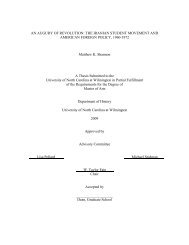HIERARCHAL INDUCTIVE PROCESS MODELING AND ANALYSIS ...
HIERARCHAL INDUCTIVE PROCESS MODELING AND ANALYSIS ...
HIERARCHAL INDUCTIVE PROCESS MODELING AND ANALYSIS ...
You also want an ePaper? Increase the reach of your titles
YUMPU automatically turns print PDFs into web optimized ePapers that Google loves.
3 COMPUTATIONAL RESULTS<br />
The main topic in this paper, is to determine how to optimize the usage we make of<br />
HIPM to assist scientists in there decision making process when it comes to selecting<br />
a model that most accurately represent an ecosystem. The first need is to narrow<br />
down the number of possible good fit models capable of describing the system. We<br />
did this feeding additional time series about one of the state variable into HIPM,<br />
thus providing more constraints; so did this assumption hold true<br />
Secondly, if<br />
adding more constraints to HIPM does reduce that number, are observations for a<br />
specific state variable holding more reducing power than the other state variables<br />
The data collected helped us answer these questions as well as discuss the efficiency<br />
of HIPM in its current state.<br />
There were thirty-one different experiments performed, each returning a measure of<br />
fit value (reMSE) every one of the 1120 models tested in every experiment. This<br />
makes for a large amount of data to analyze. To get a better idea of what this data<br />
looks like, the measures of fit values of models that had an reMSE between 0 and<br />
2 were graphed, ranking and graphing them from lowest to highest (see Figure 4, 5<br />
and 6) value. We did not look at reMSE higher than 2.0 since, as stated previously,<br />
models with reMSE higher than 1.0 are typically classified as poorly performing<br />
models as it indicates a very large difference between observed and expected values.<br />
We estimated that the (0,2) range would be sufficient for our purpose, as it would<br />
encompass most models. Based on these initial results we decided to pick an reMSE<br />
of 0.5 as our good fit model cutoff; any model under that cutoff is considered of good<br />
fit. This choice of cutoff was made because the multiple graphs seemed to exhibit a<br />
turning point or slight step pattern around this reMSE value, such as portrayed in<br />
the graph for experiments 1, 5 or 20.<br />
20
















